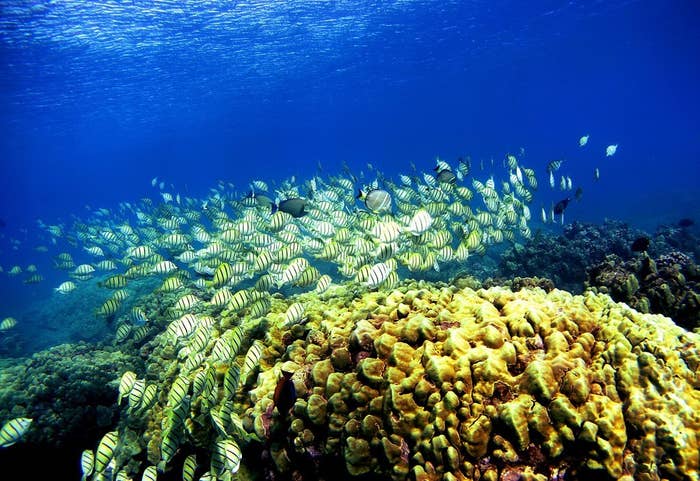
Corals in Hawaii may face their worst "bleaching" event ever this fall, which could critically weaken and potentially kill the fragile organisms.
Corals — which famously form reefs in Hawaii and other coasts around the world — feed on algae. The algae gives coral its distinctive color.
Sometimes, however, corals expel that algae, turning them white in a process called coral bleaching. That's what is going on right now in Hawaii, and experts fear this year's bleaching event could be the state's worst ever.
Ruth Gates, director of the Hawaii Institute of Marine Biology, told BuzzFeed News on Saturday that bleaching has already begun. On a recent trip out to see corals, about 10% were white, she said.
Bleaching doesn't automatically kill corals, but it does leave them more stressed, more susceptible to disease, and ultimately more likely to die.
Worse still, many of the corals around Hawaii are still recovering from a major bleaching event that happened last year, Gates said, when as much as 70% went white. Much of it recovered, but of the most severely affected areas, between 85% and 100% have since died, according to the Department of Land and Natural Resources.
"The problem now is that we have the second bleaching event coming so quickly on the heels of last year," Gates said.
As a result, Gates called this year's conditions "unprecedented" and "very worrying."
"I'm struggling to find an example where we've had two back to back bleaching events," Gates added. "This double whammy is not really common."

The bleaching is being driven by unusually high water temperatures in the ocean around Hawaii.
Henry Lau, a National Weather Service forecaster in Maui, told BuzzFeed News the water temperature around Hawaii at this time of year is normally about 77 degrees. But this year, the temperature is about 82 degrees — and the warm water could stick around for months.
"We do not expect to see sea surface temperatures really go down until early next year," Lau added.
That could spell disaster for Hawaii's corals because high water temperatures are what prompt bleaching events.
Gates said the high temperatures have arrived earlier this year than normal.
"At this time, it's very early in the year and we are way ahead of the time in which bleaching should be happening," Gates said.
So far this year, scientists already have reports of bleaching near Oahu, Maui, and the Big Island, the Associated Press reported. Moreover, a mile and a half of coral reef near a remote part of Hawaii's northeastern corner is essentially dead, a researcher told the AP. The coral apparently died from last year's bleaching event.
A powerful El Niño is helping drive up water temperatures around Hawaii and beyond.
Gates said climate change and local conditions, such as plenty of sun, contribute to warmer waters. But, she added, El Niño is a contributing factor as well, and one that could especially keep water temperatures higher for longer.
Lau agreed, saying El Niño was at least in part responsible for the high temperatures in the waters around Hawaii.
"El Niño really ratcheted up in the last couple of months," he said. "It is massive."
Other experts have said this year's El Niño could be among the strongest on record. A side-by-side comparison — based on data from NASA's Jet Propulsion Laboratory — also shows ocean temperatures following a pattern this year that resembles what happened in 1997, which saw a record-breaking El Niño:
If Hawaii's corals die as a result of this year's bleaching, the effects could wreak havoc on everything from the food chain to tourism.
Gates said corals provide the base of the food chain for both marine life and humans. She added that "70% of the protein eaten on some Pacific islands come from the reefs."

The reefs are also the basis of Hawaii's tourist economy; not only are they an attraction themselves, but they protect the beaches from things like erosion.
"All of these tourist hotels are at some level protected by reefs," she explained. "There are massive connections between the viability of a place like Hawaii and the reefs."
As a result, losing coral reefs can be devastating for both biodiversity and the economy, and Gates urged caution so as to not cause further damage.
"We need to be extremely careful about not polluting the corals, not treading on them, not anchoring on them," Gates added. "People can make a difference."
